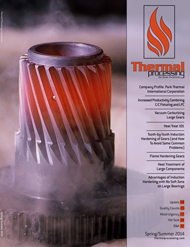Portable Rockwell Hardness Testing of Large Induction Hardened Work Pieces
The previous article identified many factors related to benchtop Rockwell hardness testing practices. This article covers work pieces that are one of a kind or are too large and too expensive to cut into small enough pieces to fit into the conventional benchtop hardness tester. The Leeb /rebound portable testers are excellent for testing both ferrous and non ferrous metals for these very large work pieces. Figure 1
With the evolution of controls for induction hardening equipment it is becoming common practice to not cut every set up to check case depth and only check surface hardness. The modern induction control system allows exact measurement of kW at the coil, quench flow, quench pressure, quench temperature, scan speed etc. These real time measurements use quality control signatures. These signatures have preset high and low set points that if any deviation occurs, that the induction process will fault and give an indication of which parameter is out of tolerance. Each part number recipe has its own distinct set of signatures. The process parameters and signatures are all stored in the hard drive for future analysis for SPC comparisons. These computer features greatly reduce and can eliminate cutting and mounting of samples for micro hardness analysis. Many induction houses use an acid etch, sandblasting or shot peening the work piece surface so the induction hardened zone is exposed and the final appearance shows the length of zones that have been induction hardened. Combine these powerful computers with hand held hardness testers can make for higher productivity and eliminate cutting of workpieces to confirm hardness case depths and the length of the heat treated zone. Figure 2
The electronic testers can convert hardness and have optional test heads with different ball diameters for softer materials and diamond for the Rockwell “C” & “B” scale, Vickers, Brinell and Shore. A large test block is also provided as bench type test blocks are too small for their use with portable testers. The attachments for confined spaces and upside/sideways testing are also available. Figure 3
Portable hardness testing equipment has come a long way since the author worked in the heat treat department. Old school “Shore” and “C” clamp style testers have been replaced with portable electronic testers. They are more accurate and have higher precision but some basic preparation rules again apply. These include:
- Clean flat surface, ground or polished and use a scotch bright pad to remove all scale.
- All machining marks, groves and tooling marks must be removed.
- Work piece firmly sitting on a hard flat surface.
- Special ordered set of rings are required to check hardness on concave or convex work pieces.
- Separate rings may be needed for different diameters or angles on large round parts.
- When changing from a ball to a diamond you must use the supplied test block.
- These portable testers are not well suited for very thin parts like sheet metal or thin walled tubing. Figure 4
Finally it should be brought out that training is critical to any industrial process. Whether it is a bench or a portable hardness tester, the importance of training can’t be stressed enough. This should include a complete understanding of the hardness test theory, machine maintenance, proper surface preparation, environmental implications and safety.

































